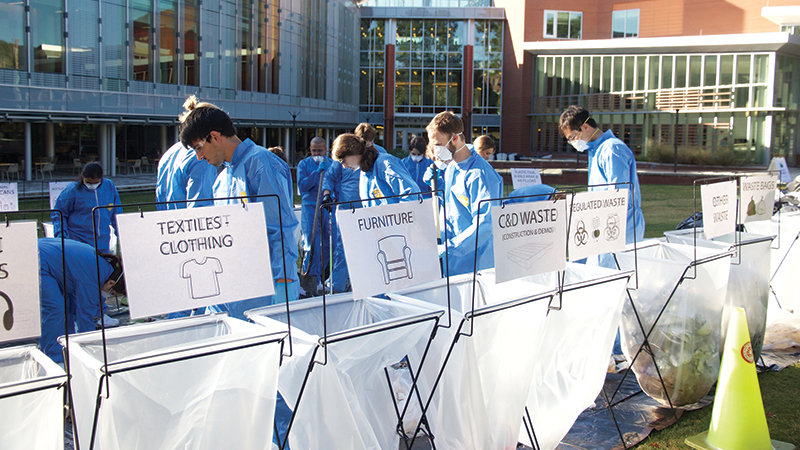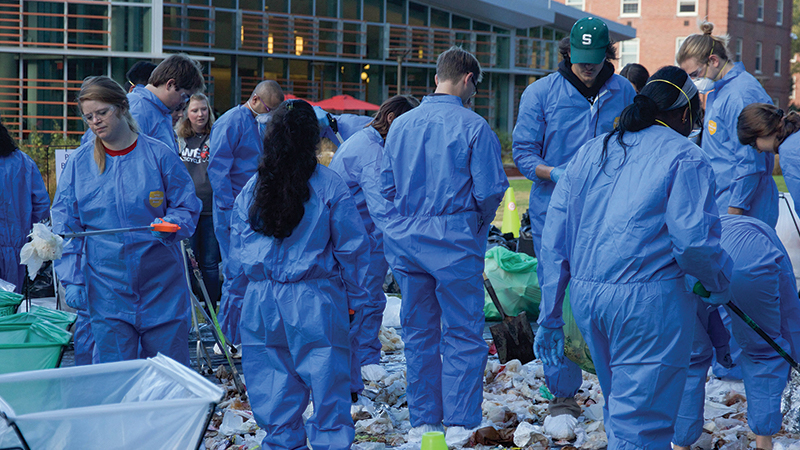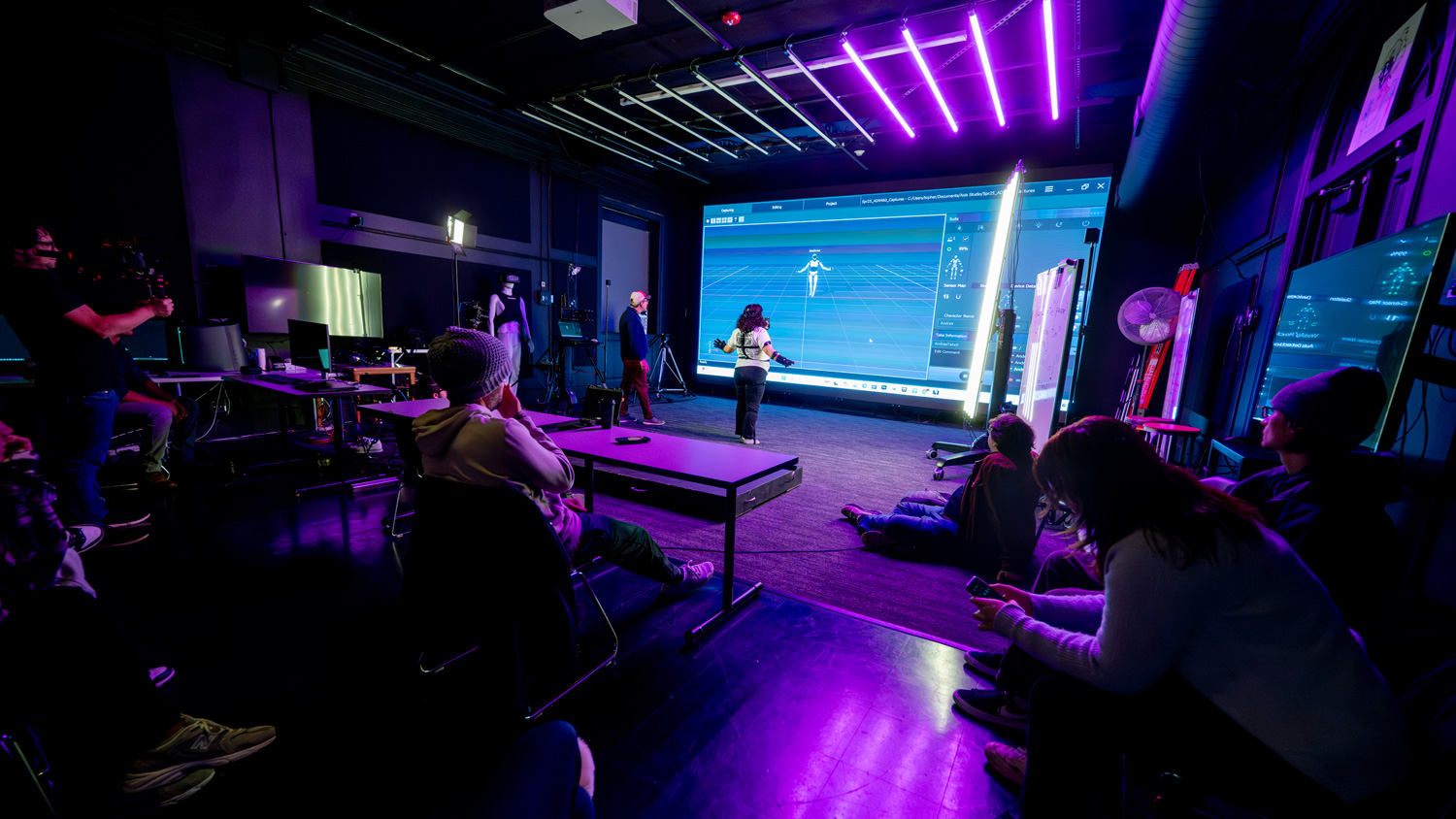The LEED Lab: Engaging Students in Sustainable Building Decisions

For three years now, Dr. Traci Rose Rider, Research Assistant Professor of Architecture, and Elizabeth Bowen, University Program Specialist in Sustainability, have led students in a lab that examines buildings on campus and how they measure up to a set of standards presented by the U.S. Green Buildings Council (USGBC). Their students, who come from a number of different disciplines, are responsible for researching and making suggestions to get NC State buildings on track to receive Leadership in Energy and Environmental Design (LEED) certification.
Since 2008, NC State has made a commitment that all new construction and major renovations will receive at least LEED Silver status. But once a building exists, it continues to make an impact on water and electricity use, waste production and emissions, pest management, maintenance, and the human experience—for a minimum of half a century. Rider’s and Bowen’s class gives students the opportunity to partner with various NC State operations and facilities to address these impacts on existing structures.
“Instead of just thinking about how to design a building for efficiency and use and occupancy, we’re actually looking at how buildings work,” says Rider, who also serves as Coordinator for the Design Initiative for Sustainability and Health at the College of Design. “Architecture programs across the board will teach you how to work toward completing a design and construction project, and hand the building over to a client; there’s not a lot of attention to what happens in those buildings after we’ve done our job.”
“Architecture programs across the board will teach you how to work toward completing a design and construction project, and hand the building over to a client; there’s not a lot of attention to what happens in those buildings after we’ve done our job.”
LEED additionally certifies Operations and Maintenance, or O+M, in buildings. Although these aspects, according to Rider, are “wildly less glamorous,” they are “absolutely important. Buildings are typically designed for 50-year lifespans, and decisions you make during the design, be they materials, mechanical zoning, infrastructure for trash and recycling leaving the building, or water use—all of that your owner’s going to have to live with for the next 50 or so years, and inefficiencies will cost them in both maintenance and occupant satisfaction.”
In its first year, the LEED Lab evaluated Nelson Hall with support from the Poole College of Management Sustainability Initiative. Then it evaluated residential Bragaw Hall with support from Campus Life. Last fall, they began considering how to make Talley Student Union the first building at NC State to become LEED O+M Certified. It is targeted as the first O+M certification in the UNC system and would become the second student union in the country to receive this certification. Talley already had LEED Building Design + Construction Silver certification, but now the lobby includes a LEED Dynamic Plaque, which uses an integrated platform called Arc to continuously monitor energy, water, waste, and other environmental impacts to track the overall performance of the building as it compares to others like it.
Doug Morton, PE, Associate Vice Chancellor of Facilities, says, “The installation of the Dynamic LEED Plaque in the Talley Student Center is the result of a thoughtful, collaborative effort between faculty, students, and staff at NC State. Each of us who understands the complexities of operating such an active building has a responsibility to share with our fellow Wolfpackers the significance of the plaque and the story it tells about the Talley Student Center.” The interactive nature of the plaque allows visitors to see how the building is performing at any given moment.
This fall, Rider and Bowen are hosting the course once again, with the support of a $5,000 grant from the Appalachian Energy Summit. This time around, they are targeting the McKimmon Conference and Training Center.
“The McKimmon Center is oftentimes a face for the university. People come and engage at McKimmon but don’t always visit the rest of the campus. Helping the folks at the McKimmon Center strengthen their presence is really important for them and the students engaged in the course,” says Rider.
The course isn’t without its challenges. McKimmon, which was originally built in 1976, includes a number of large, open rooms without a lot of daylight due to their use for classes and meetings with audiovisual display needs. The course brings together students from civil engineering, the environmental sciences, and design and architecture. Rider and Bowen lead a number of team-building exercises and icebreakers to get these groups on the same page. “We ask students to give us three myths or stereotypes about each group, including themselves. Once they vocalize some of the myths about themselves and the others, they realize how ridiculous some of the baggage they bring in to these collaborations is about other disciplines, and we ask them to leave those preconceived notions at the door,” says Rider.
“Once [students] vocalize some of the myths about themselves and the others, they realize how ridiculous some of the baggage they bring in to these collaborations is about other disciplines, and we ask them to leave those preconceived notions at the door.”
This cross-disciplinary collaboration isn’t common. Allison Menius [B.Arch ’17], who participated in last year’s LEED Lab, said, “Even though I will be entering into a profession where I will work with these individuals (students from engineering and natural resources) on a regular basis, there are not many opportunities in school to make those connections and work collaboratively.”
The expected outcome, if last fall’s class is any indication, will be an even stronger analysis of each building. “Across three main fields of study—architecture, engineering, and environmental science—every angle of each of [Talley’s] weaknesses was analyzed and discussed, leading to innovative and unique solutions,” says Madison Bose (M.Arch student).
In addition, facilities employees work with the students to gather the data needed. “Our division [the McKimmon Center for Extension and Continuing Education] mostly serves working professionals and those who may be looking at changing jobs. We don’t have as much access to degree-seeking students, so it’s a great opportunity for us to work with students and involve them in what we do,” says Chip Futrell, CPP Director for Continuing & Professional Education.
Bowen, who has held a position in facilities for many years, observed a great deal of growth in last year’s student group as they worked with Talley: “My number one takeaway for students is how to work professionally with a client and to observe deadlines. The primary client for this course was campus enterprises and facilities division; recommendations were made to both clients, and the students needed to learn to own the project and interact professionally. They were challenged to be the experts and make recommendations; however, in this case, they were experts and were challenged to be consultants.”
By the end of the fall semester, the new crop of students will have analyzed the McKimmon Center—its strengths, as well as gaps that must be addressed to attain LEED O+M certification. Once these baselines are established, students will suggest tactics or strategies to meet LEED thresholds.
“These students, who have fundamentally similar interests, come together from drastically different perspectives or approaches and pull it all together to apply their collective knowledge in a real-world setting that impacts their environment, their home here at NC State,” says Rider. “They get so excited, and they’re so dedicated to what they are trying to find, because they know it has real impact.”
- Categories:



